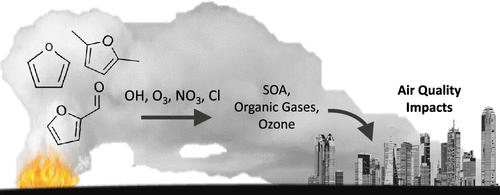当前位置:
X-MOL 学术
›
ACS Earth Space Chem.
›
论文详情
Our official English website, www.x-mol.net, welcomes your feedback! (Note: you will need to create a separate account there.)
Emissions and Atmospheric Chemistry of Furanoids from Biomass Burning: Insights from Laboratory to Atmospheric Observations
ACS Earth and Space Chemistry ( IF 3.4 ) Pub Date : 2024-04-08 , DOI: 10.1021/acsearthspacechem.3c00226 Manolis N. Romanias 1 , Matthew M. Coggon 2 , Fatima Al Ali 1, 3 , James B. Burkholder 2 , Philippe Dagaut 4 , Zachary Decker 5 , Carsten Warneke 2 , Chelsea E. Stockwell 2 , James M. Roberts 2 , Alexandre Tomas 1 , Nicolas Houzel 3 , Cecile Coeur 3 , Steven S. Brown 2
ACS Earth and Space Chemistry ( IF 3.4 ) Pub Date : 2024-04-08 , DOI: 10.1021/acsearthspacechem.3c00226 Manolis N. Romanias 1 , Matthew M. Coggon 2 , Fatima Al Ali 1, 3 , James B. Burkholder 2 , Philippe Dagaut 4 , Zachary Decker 5 , Carsten Warneke 2 , Chelsea E. Stockwell 2 , James M. Roberts 2 , Alexandre Tomas 1 , Nicolas Houzel 3 , Cecile Coeur 3 , Steven S. Brown 2
Affiliation

|
Furanoids are a class of reactive volatile organic compounds that are major products from the pyrolysis and combustion of biomass polymers, including cellulose, hemicellulose, and lignin. Biomass burning is an atmospheric source of furanoids that is increasing in frequency and intensity throughout regions of the world. Once emitted to the atmosphere, furanoids may react with the major atmospheric oxidants to form secondary pollutants that are hazardous to human health, including ozone (O3) and secondary organic aerosol (SOA). This review is a comprehensive assessment of the literature between 1977 and the present describing the emissions and atmospheric fate of furanoids emitted from wild, prescribed, and domestic fires. The review is organized by presenting the physical properties of key furanoids first, followed by a summary of the biopolymer pyrolysis and combustion reactions that lead to furanoid formation. Next, furanoid emissions factors are compiled across the typical fuels consumed by biomass burning to highlight the key species emitted in smoke. We next review the available kinetic and atmospheric degradation mechanism data that characterize the reaction rates, gas-phase products, and SOA formed as a result of furanoid reactions with OH, NO3, O3, and Cl radicals. We then describe studies that have focused on evaluating furanoid atmospheric chemistry and their impacts on air quality using a combination of field observations and model simulations. We conclude with a perspective that identifies future research directions that would address key data gaps and improve the understanding of furanoid atmospheric processes.
中文翻译:

生物质燃烧产生的呋喃类化合物的排放和大气化学:从实验室到大气观测的见解
呋喃类化合物是一类反应性挥发性有机化合物,是生物质聚合物(包括纤维素、半纤维素和木质素)热解和燃烧的主要产物。生物质燃烧是呋喃类化合物的大气来源,其频率和强度在世界各地都在增加。一旦排放到大气中,呋喃类化合物可能会与大气中的主要氧化剂发生反应,形成危害人体健康的二次污染物,包括臭氧(O 3)和二次有机气溶胶(SOA)。本综述是对 1977 年至今描述野火、规定火灾和家庭火灾排放的呋喃类化合物的排放和大气归趋的文献的综合评估。该综述首先介绍了关键呋喃类化合物的物理性质,然后总结了导致呋喃类化合物形成的生物聚合物热解和燃烧反应。接下来,对生物质燃烧消耗的典型燃料进行呋喃类化合物排放因子的编制,以突出烟雾中排放的关键物种。接下来,我们回顾了可用的动力学和大气降解机制数据,这些数据表征了呋喃类化合物与 OH、NO 3、O 3和 Cl 自由基反应形成的反应速率、气相产物和 SOA 。然后,我们描述了结合现场观测和模型模拟来评估呋喃类化合物大气化学及其对空气质量影响的研究。我们得出的结论是确定未来的研究方向,以解决关键数据差距并提高对呋喃类化合物大气过程的理解。
更新日期:2024-04-09
中文翻译:

生物质燃烧产生的呋喃类化合物的排放和大气化学:从实验室到大气观测的见解
呋喃类化合物是一类反应性挥发性有机化合物,是生物质聚合物(包括纤维素、半纤维素和木质素)热解和燃烧的主要产物。生物质燃烧是呋喃类化合物的大气来源,其频率和强度在世界各地都在增加。一旦排放到大气中,呋喃类化合物可能会与大气中的主要氧化剂发生反应,形成危害人体健康的二次污染物,包括臭氧(O 3)和二次有机气溶胶(SOA)。本综述是对 1977 年至今描述野火、规定火灾和家庭火灾排放的呋喃类化合物的排放和大气归趋的文献的综合评估。该综述首先介绍了关键呋喃类化合物的物理性质,然后总结了导致呋喃类化合物形成的生物聚合物热解和燃烧反应。接下来,对生物质燃烧消耗的典型燃料进行呋喃类化合物排放因子的编制,以突出烟雾中排放的关键物种。接下来,我们回顾了可用的动力学和大气降解机制数据,这些数据表征了呋喃类化合物与 OH、NO 3、O 3和 Cl 自由基反应形成的反应速率、气相产物和 SOA 。然后,我们描述了结合现场观测和模型模拟来评估呋喃类化合物大气化学及其对空气质量影响的研究。我们得出的结论是确定未来的研究方向,以解决关键数据差距并提高对呋喃类化合物大气过程的理解。



























 京公网安备 11010802027423号
京公网安备 11010802027423号